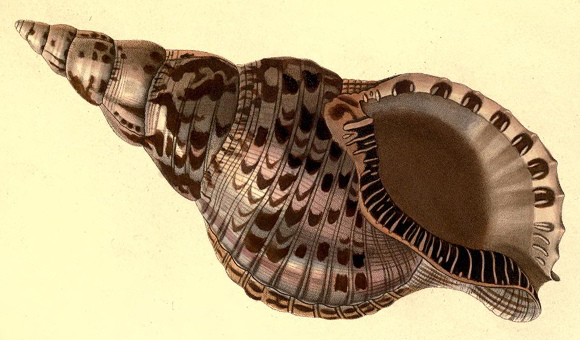Charonia variegata
Charonia variegata, Crete, Greece ( Mediterranean)
The Atlantic Triton snail ( Charonia variegata ) is a snail from the family of Triton snails ( genus Charonia ), which feeds mainly on echinoderms. She lives in the Atlantic and Mediterranean and is one of the greatest living today snails.
Features
The cone-shaped shell of Charonia variegata reaching in adult snails about 33 cm, sometimes 37.5 cm in length, has an elongated, pointed thread without knots. This, however, is more compact than the thread of the Pacific conch Charonia tritonis. The Siphonalkanal is very short. The younger whorls are inflated irregularly marked with varices and have over the seam, which descends in an irregular spiral, a bulge. Parietal is a narrow dark brown inner lip with regularly spirally arranged white wrinkles. The outer lip has inside pair of white teeth on square dark brown spots. The surface of the house is creamy white with brown crescent-shaped spots.
The body of the snail is yellow to orange with thick dark red to brown spots. The sensor, the eyes are at their broader basis, are yellow with two black stripes.
Dissemination
The Atlantic Triton snail occurs on both sides of the Atlantic Ocean on including the Caribbean Sea and the Mediterranean. In the western Mediterranean and parts of the Atlantic takes the node -bearing Triton snail ( Charonia lampas ) in its place.
Habitat
Charonia variegata living in the intertidal zone and below at depths of up to 384 meters, even on coral reefs.
Life cycle
Like other prosobranch snails are dioecious Atlantic Triton. The male mated the female with his penis. The female lays the eggs in Located solid oval egg capsules, which hatch the veliger larvae after a few weeks. The larvae go through a more than three-month pelagic phase, so that the screw on transatlantic flows is widespread. Upon metamorphosis of the completed screw, the shell has already more than 5 mm. It is the largest known veliger larvae of the Atlantic.
Nutrition
Charonia variegata feeds preferably of echinoderms ( Echinodermata ). With the acidic saliva of the screw, the prey is paralyzed and softened their calcareous skeleton. The prey is swallowed whole depending on size and consistency or drilled at one point and then blown out. Observations in Trinidad and Tobago in the 1950s showed that the Triton screw next to their preferred prey, starfish and sea urchins, has a fairly wide food spectrum. Thus while the Triton screw also sea cucumbers, mussels, snails, and even young Caribbean spiny lobster prey. In the latter case, a lobster resisted even when the screw is already drilled a hole between the abdomen and carapace. The preferred prey apparently also influenced the housing color, so this was very stressed colorful, while she was massenweisem after consumption of orange starfish Echinaster sentus after vorwiegendem consumption of sea urchins rather pale.
Endangering
Because of the impressive housing the Atlantic Triton snail is collected. According to the German Federal Species Protection Ordinance (Appendix 1) the populations of the Mediterranean are protected.
System
Charonia variegata is regarded by some biologists as a subspecies of Charonia tritonis, Charonia tritonis variegata, on the other hand, according WoRMS recognized as a separate species.







